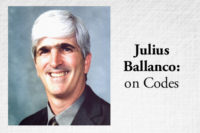
The plumbing code hearing took place last November, during the second week of the International Code Council’s (ICC) code changes meeting in Baltimore. Ray Moore, P.E., did an excellent job of Chairing the Committee. This year the code changes were only provided in electronic format, as the ICC went green. There were no code change books.
Two Tracks of Changes
There were many changes proposed to the fixture requirements. Most changes would add plumbing fixtures. The Committee approved a change to double the fixture requirements in small restaurants. However, there was no technical basis for the change other than the proponent “thought it was a good idea.”Two tracks of code changes ran simultaneously: the plumbing hearings in one room, the fire safety hearings in the next room. As it turns out, one of the fire safety issues regarding plumbing (water riser and trap coverings) was being addressed at the same time the plumbing code was reviewing fixture requirements.
I could not be in two places at one time, so I sat through the fire safety issue regarding water riser and trap coverings. A proposal would have added requirements to mandate a flame spread of 25 and a smoke developed rating of 450 for protective covers used on handicapped sinks or lavatories.
Those wanting this requirement added to the code lined up people to support their position. What shocked me was the equal amount of people lined up to testify against the change.
The Fire Safety Committee, not being used to plumbing arguments, had a mixed response to the proposed change. The Committee recommended that the change be denied. One of the Committee members commented that it made no sense to apply a Class 1 rating to a Class 3 room. In other words, why have a special rating for covering when the exposed pipe on the adjacent lavatory has no rating? Similar changes to the plumbing code were also denied.
One of the design changes that will impact plumbing engineers is the requirements for hot water recirculation. Currently, the code only requires temperature maintenance when the distance from the water heater to the most remote outlet exceeds 100 feet.
Two proposed changes recommended a reduction of that distance, so the Committee approved a lowering of the distance to 50 feet. This will significantly increase the amount of required hot water recirculation. The change is also a move toward green design that engineers should embrace.
Other proposed changes concerned drainage and vent system design. A change to allow air admittance valves for special waste systems was recommended for approval. Also, ASSE 1049, the new ASSE standard for chemical waste-type air admittance valves, was added to the code.
The single-stack venting system (more commonly known as Philadelphia single stack) that has been championed by ASPE was recommended for approval. Comments were made against the change, but the Committee approved it overwhelmingly. The single-stack venting section parallels the requirements in the Philadelphia Plumbing Code.
One proposed change would have prohibited food waste grinders from discharging through a grease interceptor. An exception was made to allow the practice when required by the local jurisdiction. In such an installation, a solids interceptor would be required ahead of the grease interceptor.
While this is a common sense type of code change, it got bogged down regarding when a jurisdiction could require such an installation. The change was recommended for denial, and the Committee suggested that this change be reworked for the final hearing.
Siphonic roof drainage was again proposed to the storm drainage chapter, which had a considerable amount of discussion regarding the ASPE standard, ASPE 45. One of the testifiers claimed that his negative comments were not properly addressed. The proponents responded to each of these negative comments. It was pointed out that every negative comment was addressed; however, some of those commenting did not like the responses. That, of course, occurs with every consensus standard.
Some code officials indicated that the siphonic roof drainage system was complex and difficult for them to understand. While the complexity of the change was addressed, it was pointed out that other very complex standards are already referenced in the ICC codes.
The Committee recommended the approval of the system with a minor amendment that added the ASME material standard for siphonic roof drains.
The Longest Change
The longest code change proposed sought to take the appendix on greywater piping systems from the code and move it into the body of the code. Although it wasn’t new, the proposal still drew discussion. One person complained that the technology in the appendix was out of date and incomplete.Another person pointed out that the requirements have no stipulation regarding the quality of greywater, noting the section only states that it shall be of an acceptable quality. When used for flushing, greywater is required to be dyed a blue or green color. This is another archaic requirement that is a holdover from many years ago.
The Committee felt obligated to approve the section, even though it needs updating. One can only hope that a public comment is submitted to make the necessary correction to this new chapter. While everyone agrees that the code needs to address reclaimed water, this new chapter is not the way to do it.
Any reclaimed water section needs to addressallreclaimed water, not just greywater. That section would include rainwater harvesting, ground water, municipal reclaimed water and black water systems. Without the inclusion of all reclaimed water, the code will be woefully incomplete.
The deadline for submitting public comments is Feb. 8, 2010. The final hearing for the plumbing code changes will take place in Dallas, TX, in May. If you would like to download a complete listing of the code change results, go towww.iccsafe.org. The Web site also has the necessary forms for submitting a public comment.


